|
|
|
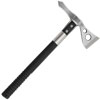 |
|
| SOG Fusion Tactical Tomahawk Satin (F01P) |
Points: 3

|
Based on the Vietnam Tomahawk, the new Fusion Tactical Tomahawk is an extreme evolution of the original, which was considered one of the more unusual weapons of its day. Today there is a real need for a versatile tool for breaching operations, excavation, obstacle removal, extraction, and other utility applications. The 420 stainless steel head is mounted to the fiberglass reinforced nylon handle with heavy-duty bolts and a steel ferrule to keep the wood from splitting. Side hammer checkering insures precise placement when pounding. Carried in a nylon sheath(F01P) this is a universal tool for modern man.
Also available with black molded hard Tactical Tomahawk Nylon Sheath (F01PK) with 360° rotating clip
Sold Out
|
|
|
|
|
|
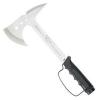 |
|
| United Cutlery Bushmaster Survival Axe (UC2962) |
Points: 3
|
This Bushmaster survival axe covers all the bases, providing you with a durable tool that can tackle anything that comes your way. The razor-sgharp 420 stainless steel blade features a deep blood groove. The ergonomically designed hand grip has a knuckle guard. Includes a black nylon sheath that houses a survival kit and sharpening stone. The survival kit features sewing needles, fish hooks, band aids, fishing line and sinkers, hooks, matches, alcohol swabs, fire starter with compass, survival whistle, snake bite kit and several feet of survival paracord.
Sold Out
|
|
|
|
|
|
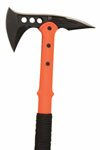 |
|
| United M48 Kommando Survival Rescue Axe Orange (UC2821) |
Points: 5

|
This M48 Kommando Survival Rescue Axe is the ultimate tactical tool. It is lightweight to be carried all day without added muscle fatigue, and the blade of the M48 Kommando Axe offers a wide, upswept axe blade. The axe head is constructed of precision cast 2Cr13 stainless steel. When combined with the backside of the head, the spike and axe head make for an efficient personal defense and breaching tool as well as a great camping tool with an extremely fast chopping edge. The blade is securely attached to the sturdy nylon reinforced bright orange handle with 30% fiberglass and three separate bolts. Includes nylon snap button sheath. 8” bl, 15” overall.
Sold Out
|
|
|
|
|
|
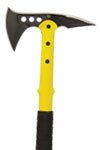 |
|
| United M48 Kommando Survival Rescue Axe Yellow (UC2820) |
Points: 5

|
This M48 Kommando Survival Rescue Axe is the ultimate tactical tool. It is lightweight to be carried all day without added muscle fatigue, and the blade of the M48 Kommando Axe offers a wide, upswept axe blade. The axe head is constructed of precision cast 2Cr13 stainless steel. When combined with the backside of the head, the spike and axe head make for an efficient personal defense and breaching tool as well as a great camping tool with an extremely fast chopping edge. The blade is securely attached to the sturdy nylon reinforced bright orange handle with 30% fiberglass and three separate bolts. Includes nylon snap button sheath. 8” bl, 15” overall.
Sold Out
|
|
|
|
|
|
 |
|
| M48 Apocalypse Tactical Tomahawk (UC2946) |
Points: 5

|
This M48 Apocalypse tactical tomahawk is the ultimate tactical weapon. It is lightweight to be carried all day without added muscle fatigue and the blade of this offers a wide, upswept axe blade for mammoth chopping, slashing and zombie cutting potential. The secondary edge on the back side of the head is specially sharpened on both edges for a cutting and hooking attack. When combined, the spike and axe head make for an efficient personal defense and breaching tool against the zombie horde. The blade is securely attached to the paracord-wrapped, 30% nylon reinforced handle with three separate bolts. Includes a durable nylon belt sheath with belt loop and snap closure buttons.
Sold Out
|
|
|
|
|
|
 |
|
| Kit Rae Aircobra Throwing Axe (KR0055) |
Points: 5

|
The Aircobra is constructed of one solid piece of AUS-6 stainless steel and features a leather wrapped grip. Also features a balanced handle-to-blade design for perfect throwing, with a rear blade spike. Includes a reinforced leather composite sheath. 10 3/4" ov.
Sold Out
|
|
|
|
|
|
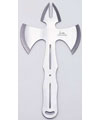 |
|
| Hibben Generation 2 Pro Thrower Axe (GH2013) |
Points: 3
|
Designed by Gil Hibben, who is a master knifemaker, an avid knife thrower, and author of the Hibben Knife Throwing Guide (UC0882 sold separately). The Generation 2 Pro Thrower Axe is constructed of one-piece tempered stainless steel and features a perfectly balanced double axe head and a "trigger grip" handle design that guides the hand into the same consistent and accurate release each time it is thrown. The four-edged double-function design can be thrown to strike point or axe edge first. Includes a genuine leather belt sheath. Gil Hibben throwers are the most popular and most imitated throwers on the market today. Only accept a genuine Hibben original!
Blade/Handle Material: Tempered, 420 J2 stainless steel.
Sheath: Genuine black leather with belt loop.
Sold Out
|
|
|
|
|
|
 |
|
| The NEW LaGana Tactical Tomahawk (VTAC) |
Points: 7

|
The LaGana Tactical Tomahawk (a.k.a. VTAC) is the standard by which all other tactical axes are judged, period. Battle proven for over 40 years, Peter LaGana`s axe-head design has served the United States in every major conflict since the Vietnam War. Modernized with 21st century materials and workmanship, the new LaGana Tactical Tomahawk sets the bar for ease of carry, toughness, and versatility. No axe in the War on Terror has seen and done more...
Sold Out
|
|
|
|
|
|
 |
|
| Sibert Comanche Tomahawk (COMT) |
Points: 9

|
Our premiere "integral construction" Tomahawk, the aggressive shape of the Sibert Comanche blends the spontoon functionality of the "Lewis and Clark" design with tactical features. Strong, well-balanced, and mean, the Comanche is ready to raid your next drug lab or terrorist cell now.
Designed by rising star Shane Sibert
Sold Out
|
|
|
|
|
|
 |
|
| American Tomahawk CQC-T Emerson Design Tomahawk (ATCQCT) |
Points: 9

|
Ernest Emerson needs no introduction. Suffice it to say, the CQC-T is the culmination of Mr. Emerson’s tactical genius brought to bear on American Tomahawk’s experience in producing extreme-use axes.
The CQC-T’s lines represent speed, efficiency, and simplicity... in other words, "what works". Designed primarily as a personal combat tool, the CQC-T is grace in motion. It’s light, fast, and accurate. The retention rings in its textured nylon handle provide a sure, positive grip.
There is nothing else like it, period.
The CQC-T is a personal combat tool, first and foremost. We do not recommend you purchase it as a throwing Tomahawk. It's handle design and blade geometry is meant for retention and aggressive cutting, respectively.
Sold Out
|
|
|
|
|
|
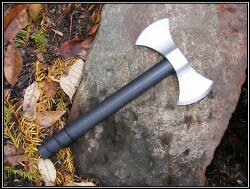 |
|
| American Tomahawk Nessmuk Tactical Axe (FKDBLB) |
Points: 20
|
This new design from American Tomahawk! Two edged axe uses the same handle material as LaGana Tactical Tomahawk a.k.a. VTAC. One edge is designed for chopping while the other is designed for whittling.
Features:
Steel: Billet Machined 0-1, HRC 56-58
Handle: ST(super-tough) modified nylon
Ergonomics: Oval Design Specialized O-Rings for added retention
Overall Weight: 18 oz w/o sheath
Cutting Edge Length: 3"
Handle Length: 10 3/4"
Kydex Belt Loop sheath
Made in the USA
Sold Out
|
|
|
|
|
|
 |
|
| Cold Steel Vietnam Tomahawk (90VT) |
Points: 6
|
Light enough to be carried all day without causing undue fatigue.
The primary edge offers a tremendous cutting,slashing and chopping potential. The secondary edge on the lower side is speciallly curved and partially sharpened for both a cutting and hooking attack, and the "V" shaped spike on the back, makes this efficient for almost any situation.
Steel: Drop Forged 1055 Carbon
Handle: American Hickory
Sheath: Leather Sheath
Sold Out
|
|
|
|
|
|
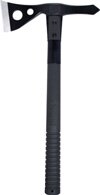 |
|
| SOG Fusion Tactical Tomahawk (F01TK) |
Points: 4

|
Based on the Vietnam Tomahawk, the new Fusion Tactical Tomahawk is an extreme evolution of the original, which was considered one of the more unusual weapons of its day. Today there is a real need for a versatile tool for breaching operations, excavation, obstacle removal, extraction, and other utility applications. The 420 stainless steel head with Hardcased coating is mounted to the fiberglass reinforced nylon handle with heavy-duty bolts and a steel ferrule to keep the wood from splitting. Side hammer checkering insures precise placement when pounding. Carried in a nylon sheath(F01T) this is a universal tool for modern man.
Also available with black molded hard Tactical Tomahawk Nylon Sheath (F01TK) with 360° rotating clip
Sold Out
|
|
|
|
|
|
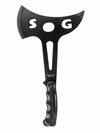 |
|
| SOG Fusion Battle Ax (F02T) |
Points: 3
|
SOG modern battle/throwing ax evokes its origins from medieval times, which some might consider to be the present. Whether used as a target ax, SWAT tool, universal back up, or hung above the fireplace; it is very effective. The pike in the back is upswept for better target penetration. Size and heft are balanced for optimum swing control. The handle is sculpted from heavy duty black Pakka wood and the entire solid blade is protected with SOG`s Hardcased coating. Nylon sheath included.
Sold Out
|
|
|
|
|
|
|
|
Tags:
swords, sword, katana, wakizashi, tanto, japanese sword, medieval sword, viking sword, japanese swords, medieval swords, viking swords, knife, knives, saber, armour, movie swords, movie replicas, martial arts, sporting goods, sporting equipment,
|

















